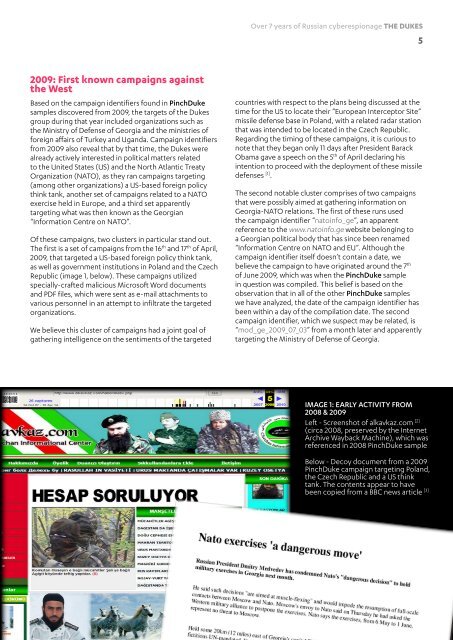THE DUKES
w75flE
w75flE
You also want an ePaper? Increase the reach of your titles
YUMPU automatically turns print PDFs into web optimized ePapers that Google loves.
Over 7 years of Russian cyberespionage <strong>THE</strong> <strong>DUKES</strong><br />
5<br />
2009: First known campaigns against<br />
the West<br />
Based on the campaign identifiers found in PinchDuke<br />
samples discovered from 2009, the targets of the Dukes<br />
group during that year included organizations such as<br />
the Ministry of Defense of Georgia and the ministries of<br />
foreign affairs of Turkey and Uganda. Campaign identifiers<br />
from 2009 also reveal that by that time, the Dukes were<br />
already actively interested in political matters related<br />
to the United States (US) and the North Atlantic Treaty<br />
Organization (NATO), as they ran campaigns targeting<br />
(among other organizations) a US-based foreign policy<br />
think tank, another set of campaigns related to a NATO<br />
exercise held in Europe, and a third set apparently<br />
targeting what was then known as the Georgian<br />
“Information Centre on NATO”.<br />
Of these campaigns, two clusters in particular stand out.<br />
The first is a set of campaigns from the 16 th and 17 th of April,<br />
2009, that targeted a US-based foreign policy think tank,<br />
as well as government institutions in Poland and the Czech<br />
Republic (image 1, below). These campaigns utilized<br />
specially-crafted malicious Microsoft Word documents<br />
and PDF files, which were sent as e-mail attachments to<br />
various personnel in an attempt to infiltrate the targeted<br />
organizations.<br />
We believe this cluster of campaigns had a joint goal of<br />
gathering intelligence on the sentiments of the targeted<br />
countries with respect to the plans being discussed at the<br />
time for the US to locate their “European Interceptor Site”<br />
missile defense base in Poland, with a related radar station<br />
that was intended to be located in the Czech Republic.<br />
Regarding the timing of these campaigns, it is curious to<br />
note that they began only 11 days after President Barack<br />
Obama gave a speech on the 5 th of April declaring his<br />
intention to proceed with the deployment of these missile<br />
defenses [1] .<br />
The second notable cluster comprises of two campaigns<br />
that were possibly aimed at gathering information on<br />
Georgia-NATO relations. The first of these runs used<br />
the campaign identifier “natoinfo_ge”, an apparent<br />
reference to the www.natoinfo.ge website belonging to<br />
a Georgian political body that has since been renamed<br />
“Information Centre on NATO and EU”. Although the<br />
campaign identifier itself doesn’t contain a date, we<br />
believe the campaign to have originated around the 7 th<br />
of June 2009, which was when the PinchDuke sample<br />
in question was compiled. This belief is based on the<br />
observation that in all of the other PinchDuke samples<br />
we have analyzed, the date of the campaign identifier has<br />
been within a day of the compilation date. The second<br />
campaign identifier, which we suspect may be related, is<br />
“mod_ge_2009_07_03” from a month later and apparently<br />
targeting the Ministry of Defense of Georgia.<br />
IMAGE 1: EARLY ACTIVITY FROM<br />
2008 & 2009<br />
Left - Screenshot of alkavkaz.com [2]<br />
(circa 2008, preserved by the Internet<br />
Archive Wayback Machine), which was<br />
referenced in 2008 PinchDuke sample<br />
Below - Decoy document from a 2009<br />
PinchDuke campaign targeting Poland,<br />
the Czech Republic and a US think<br />
tank. The contents appear to have<br />
been copied from a BBC news article [3]


